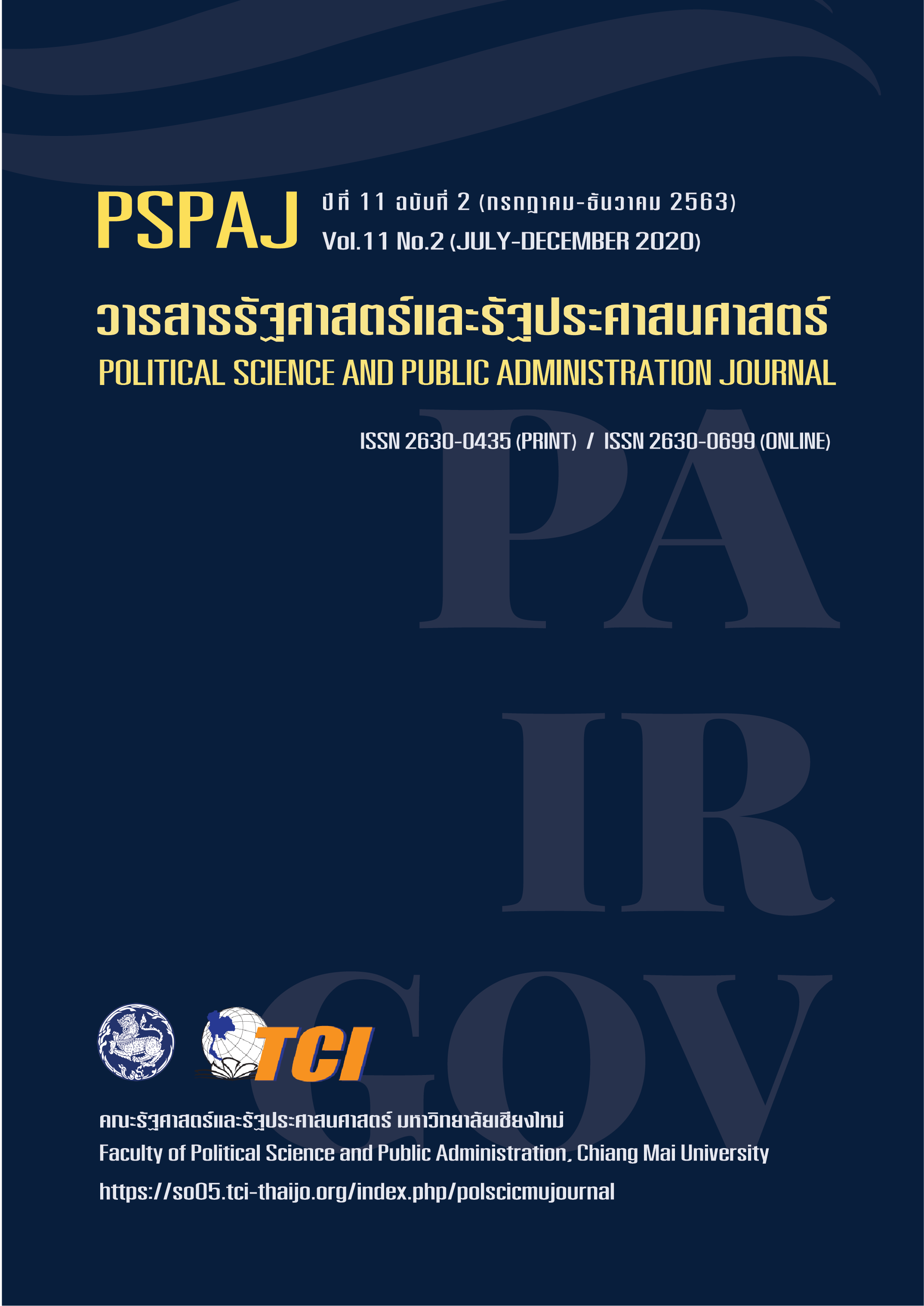Public Value Creation Process of Innovation Community Forest Management Project Nonghai Village, Khuangpao Subdistrict Administrative Organization, Chomthong District, Chiang Mai Province
Main Article Content
Abstract
The research aims to 1) investigate the public value creation process of innovation community forest management project in Nonghai village and 2) study the roles of the involved parties that help to develop public value creation process of innovation through community forest management project in Nonghai village. The snowball sampling technique was applied in this qualitative research. Thirty subjects comprising of local people, community leaders, government officers and civilians, were randomly selected by non-probability sampling and purposive sampling techniques. Data was collected through document study, semi-structured interviews, and observations. The results show that the integrated collaboration between all parties was formed as the public value creation process into 4 stages: 1) co-experience, 2) co-define, 3) co-elevation, and 4) co-development.
Article Details
- เนื้อหาและข้อมูลที่ลงตีพิมพ์ในวารสารรัฐศาสตร์และรัฐประศาสนศาสตร์ถือเป็นข้อคิดเห็นและความรับผิดชอบของผู้เขียนบทความโดยตรง ซึ่งกองบรรณาธิการวารสารรัฐศาสตร์และรัฐประศาสนศาสตร์ ไม่จำเป็นต้องเห็นด้วย หรือร่วมรับผิดชอบใดๆ
- บทความและข้อมูล ที่ได้รับการตีพิมพ์ในวารสารรัฐศาสตร์และรัฐประศาสนศาสตร์ ถือเป็นลิขสิทธิ์ของวารสาร หากบุคคลหรือหน่วยงานใดต้องการนำข้อมูลไปใช้ประโยชน์ในทางวิชาการ ขอให้อ้างอิงแหล่งที่มาด้วย
References
กิติศักดิ์ ชลศิริ. (2556). สิทธิในการจัดการป่าชุมชนของชุมชนเวียงด้ง ตำบลเวียง อำเภอฝาง จังหวัดเชียงใหม่ (วิทยานิพนธ์รัฐศาสตรมหาบัณฑิต), มหาวิทยาลัยเชียงใหม่.
กีรติ ยศยิ่งยง. (2552). องค์กรแห่งนวัตกรรม แนวคิด และกระบวนการ. กรุงเทพฯ: โรงพิมพ์แห่งจุฬาลงกรณ์มหาวิทยาลัย.
จักรพงษ์ พวงงามชื่น, สวิชญา ศุภอุดมฤกษ์ ตรีรัตน์, และนคเรศ รังควัต. (2556). การพัฒนารูปแบบการมีส่วนร่วมของประชาชนในการจัดการป่าชุมชน: กรณีศึกษา บ้านทาป่าเปา ตำบลท่าปลาดุก อำเภอแม่ทา จังหวัดลำพูน (รายงานการวิจัย). เชียงใหม่: มหาวิทยาลัยแม่โจ้.
ปิติพร ทองจำรูญ. (2558). การมีส่วนร่วมในการอนุรักษ์ป่าชุมชนบ้านหนองห่าย ตำบลข่วงเปา อำเภอจอมทอง จังหวัดเชียงใหม่ (วิทยาศาสตรมหาบัณฑิต (ส่งเสริมการเกษตร)), มหาวิทยาลัยเชียงใหม่.
ปิยากร หวังมหาพร. (2560). รัฐประศาสนศาสตร์ไทย:การจัดการภาครัฐแบบประชารัฐ.กรุงเทพฯ: จุฬาลงกรณ์มหาวิทยาลัย.
พรเทพ ศรีธนาธร. (2553). การจัดการป่าชุมชนท้องถิ่นอย่างยั่งยืน: กลไกการจัดการ การมีส่วนร่วมและความสำเร็จของชุมชนในการอนุรักษ์ป่าชุมชนห้วยแม่หิน จังหวัดลำปาง. (วิทยานิพนธ์รัฐศาสตรมหาบัณฑิต), สถาบันบัณฑิตพัฒนบริหารศาสตร์.
พรพิมล ชำรัมย์. (2556). การจัดการป่าชุมชนในฐานะที่เป็นทรัพยากรวัฒนธรรม กรณีศึกษา: บ้านสามขา หมู่ที่ 6 ตำบลหัวเสือ อำเภอแม่ทะ จังหวัดลำปาง. (วิทยานิพนธ์ศิลปศาสตรมหาบัณฑิต), มหาวิทยาลัยศิลปากร.
ศูนย์สารสนเทศ สำนักแผนงานและสารสนเทศกรมป่าไม้. (2560). สถิติป่าไม้. สืบค้นเมื่อ 12 ธันวาคม 2560, จาก http://forestinfo.forest.go.th/Content.aspx?id=1
สำนักงานคณะกรรมการเศรษฐกิจและสังคมแห่งชาติ. (2535). แผนพัฒนาเศรษฐกิจและสังคมแห่งชาติฉบับที่เจ็ด (พ.ศ. 2535–2539). สืบค้นเมื่อ 6 มีนาคม 2561, จาก https://www.nesdb.go.th/ewt_dl_link.php?nid=3782
______. (2555). แผนพัฒนาเศรษฐกิจและสังคมแห่งชาติฉบับที่สิบเอ็ด (พ.ศ. 2555-2559). สืบค้นเมื่อ 6 มีนาคม 2561, จาก https://www.nesdb.go.th/download/article/article_20160323112431.pdf
องค์การบริหารส่วนตำบลข่วงเปา. (2559). เอกสารประกอบการประเมินเกณฑ์ชี้วัดสำหรับการคัดเลือกองค์การปกครองส่วนท้องถิ่นที่มีการบริหารจัดการที่ดี. เชียงใหม่: องค์การบริหารส่วนตำบลข่วงเปา.
______. (ม.ป.ป.). ประวัติความเป็นมาองค์การบริหารส่วนตำบลข่วงเปา. สืบค้นเมื่อ 26 ตุลาคม 2561, จาก http://www.govesite.com/khuaopaotestworkingwebsite/content.php?cid=20150529143029xeuDLH0
Battarbee, K. (2003). Defining Co-Experience.University of Art and Design Helsinki, Helsinki, Finland.
Dunavnet, D. D. (2017). Welive - A New Concept of Public Administration Based on Ctizen Co-creation Mobile Urbanservice. Retrieve June 26, 2018, from https://www.slideshare.net/DunavNET/we-live-a-new-concept-
Farr, M. (2015). Co-Production and Value Co-Creation in Outcome-Based Contracting in Public Services. Public Administration Review, 18(5), 655-672.
Gronroos, C. (2011). Value Co-creation in Service Logic a Critical Analysis. Journal Maketing Theory, 11(3), 280-291.
Gronroos, C., & Paivi, V. (2013). Critical Service Logic: Making Sense of Value Creation and Co-Creation. Journal of the Academy of Marketing Science, 41(2), 133-150.
Hidayati, R., & Novani, S. (2015). A Conceptual Complaint Model for Value Co-creation Process. Industrial Engineering and Service Science, (4), 412–418.
Romero, D., & Molina, A. (2011). Collaborative Networked Organisations and Customer Communities: Value Co-Creation and Co-Innovation in the Networking Era. Production Planning and Control, 22(5-6), 447-472.
Skalen, P., Karlsson, J., Engen, M., & Magnusson, P. R. (2017). Understanding Public Service Innovation as Resource Integration and Creation as Value Proposition. Australian journal of Public Administration, 77(4), 1-6.
Vargo, S. L., Maglio, P. P. & Akaka, M. A. (2008). On Value and Value Co-Creation: A Service Systems and Service Logic Perspective. European Management Journal, 26(3), 145-152.


